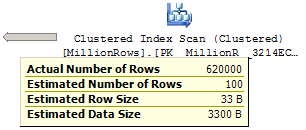My SQL Server Execution plan is a lier!
In preparation for my talk today at the Adelaide SQL Server User Group (AdSSUG) on what’s new in SQL11, I’ve been putting together a few T-SQL demos based on the talk given by Tobias Ternström at the PASS Summit 2010.
One new feature that I’m really liking is the new OFFSET operator so I thought I would give it a closer look comparing it to traditional paging methods.
To start I put together a simple query using the AdventureWorks2008 database just to see the execution plan that was generated -
select CustomerID, StoreID, TerritoryID, AccountNumber, ModifiedDate
from Sales.Customer
order by CustomerID
offset 10 rows
fetch next 10 rows only
With the plan as follows:
I then compared the query with the current equivalent using a CTE -
WITH a AS ( -- CTE
SELECT ROW_NUMBER() OVER (ORDER BY CustomerID) AS RowNum, -- Ranking by CustomerID
CustomerID, StoreID, TerritoryID, AccountNumber, ModifiedDate
from Sales.Customer
)
SELECT a.CustomerID, a.StoreID, a.TerritoryID, a.AccountNumber, a.ModifiedDate
FROM a
WHERE a.RowNum BETWEEN 10 AND 20
ORDER BY RowNum;
When comparing the two execution plans the OFFSET clause performed slightly better 0.003964 vs. 0.0033952 excellent! So I then decided to raise the stakes a little, to see what happens when paging a much larger data set.
I created a test table with about 2 million rows -
-- Create a table of numbers
create table dbo.nums (num int primary key);
insert dbo.nums values (1);
go
insert dbo.nums select num + count( * ) over () from dbo.nums;
go 20
create table dbo.MillionRows
(ID int identity(1,1) primary key,
someDate datetime not null,
someVarchar varchar(20) not null)
-- Insert 2000000 rows
insert dbo.MillionRows
select dateadd(second, num, '20000101') as someDate, 'Number ' + cast(num as varchar(10)) as someVarchar
from dbo.nums
where num <= 2000000;
I then ran both paging queries to collect 20 000 rows this time with the time statistics turned on -
SET STATISTICS TIME ON
GO
WITH a AS ( -- CTE
SELECT
ROW_NUMBER() OVER (ORDER BY ID) AS RowNum,
ID, someDate, someVarchar
from dbo.MillionRows
)
SELECT a.ID, a.someDate, a.someVarchar
FROM a
WHERE a.RowNum BETWEEN 600001 AND 620000
ORDER BY RowNum;
-- New way
select ID, someDate, someVarchar
from dbo.MillionRows
order by ID
offset 600000 rows
fetch next 20000 rows only;
SET STATISTICS TIME OFF;
GO
Once I ran it I got a surprise, upon looking at the execution plan the OFFSET paging performs horribly.
But looking at the execution times reveals the exact opposite -
| 0.0038488 | CPU time = 703 ms, elapsed time = 1158 ms. |
| 2.93175 | CPU time = 172 ms, elapsed time = 608 ms. |
Something isn’t quite right here…
To get to the bottom of the problem I asked Rob Farley for some help and quickly discovered that the Query Optimiser had incorrectly estimated the amount of rows returned by the clustered index scan causing the plan to wrongly assume that the CTE was better!
So the good news is that is safe to use the OFFSET clause :)
For more info on Paging and performance have a look at this great post by Dave Ballantyne - http://sqlblogcasts.com/blogs/sqlandthelike/archive/2010/11/19/denali-paging-key-seek-lookups.aspx


